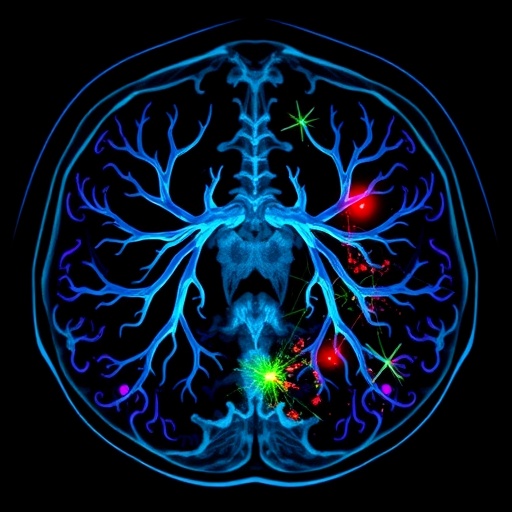In a groundbreaking study poised to transform oncologic imaging, researchers have harnessed the power of machine learning to distinguish between benign and malignant adrenal lesions with unprecedented precision. Utilizing 18F-FDG PET/CT scanning combined with advanced computational analytics, this pioneering work addresses one of the most challenging diagnostic dilemmas in endocrinology and oncology: accurately characterizing adrenal masses when conventional imaging yields ambiguous results.
Adrenal lesions are frequently discovered incidentally during routine imaging, especially in cancer patients. However, differentiating whether these lesions are harmless benign growths or malignant tumors harboring metastatic disease carries profound implications for patient management and prognosis. Traditional imaging modalities and clinical assessments often fall short, leading to potential overtreatment or missed diagnoses. This study confronts that issue head-on by integrating metabolic and anatomical data with sophisticated machine learning algorithms.
The research team retrospectively analyzed a robust cohort of 255 patients who underwent 18F-FDG PET/CT, extracting a suite of imaging biomarkers known to reflect tumor biology. These included adrenal maximum standardized uptake value (SUVmax), peak SUV (SUVpeak), tumor size, CT attenuation values, and the tumor-to-liver SUVmax ratio (T/L SUVmax). Clinical parameters were also considered to enrich the dataset, facilitating a comprehensive representation of lesion characteristics.
The investigators designed a two-stage classification framework: the first tasked with binary discrimination between benign and malignant adrenal lesions, and the second focusing on subclassifying malignant tumors into lung cancer metastases or lymphoma—a critical differentiation guiding therapeutic approaches. To maximize performance, seven distinct machine learning models were trained and rigorously tested through 10-fold cross-validation, ensuring robust evaluation and minimizing overfitting.
Among the algorithms, ensemble methods including Random Forest, Bagging, and XGBoost demonstrated extraordinary accuracy for the initial classification task, achieving an area under the curve (AUC) greater than 0.99. Notably, the Bagging model achieved a flawless recall of 100%, indicating perfect sensitivity in detecting malignancy without false negatives—a clinically invaluable attribute. Such performance metrics suggest these models can revolutionize early adrenal lesion characterization.
Delving deeper into feature importance, the study employed SHapley Additive exPlanations (SHAP) analysis to unravel the inner workings of the machine learning models, imparting interpretability often lacking in black-box AI systems. This technique revealed that the tumor-to-liver SUVmax ratio, adrenal SUVmax, and CT attenuation were the paramount features driving diagnostic decisions, underscoring the complementary roles of metabolic activity and tissue density measurements.
In the secondary task of discriminating malignant subtypes, an artificial neural network (ANN) emerged as the best performer, reaching an AUC of 0.887 and an F1-score of 0.851. These results illuminate the nuanced biological differences between lung cancer metastases and lymphoma within the adrenal gland, with SHAP analysis highlighting higher metabolic indices in lymphoma and elevated CT attenuation values characteristic of lung tumor metastasis.
The integration of PET-derived metabolic markers with CT structural features epitomizes a paradigm shift whereby multi-parametric imaging data, coupled with explainable AI, can yield precise, actionable insights for clinicians. This fusion fosters personalized medicine, tailoring interventions to lesion biology revealed through non-invasive imaging and computational analysis.
Beyond accuracy, the study’s emphasis on interpretability addresses growing concerns about AI transparency in healthcare. By elucidating how individual radiologic features influence model predictions, SHAP empowers practitioners to comprehend and trust machine learning outputs, facilitating their adoption in clinical workflows and enhancing patient communication.
The implications extend to oncologic staging, surgical planning, and surveillance strategies. Accurately identifying malignant lesions that require intervention versus benign nodules that warrant conservative management can reduce unnecessary surgeries, biopsies, and associated morbidity. Furthermore, reliable subtyping informs oncologists in selecting targeted therapies, particularly relevant for lymphoma and metastatic lung cancer which have divergent treatment algorithms.
Importantly, the study’s retrospective design leverages existing clinical imaging data, highlighting the feasibility of implementing these models in real-world settings without necessitating costly new protocols. This adaptability accelerates translation from research to bedside, where timely and accurate diagnosis profoundly impacts outcomes.
Looking forward, researchers anticipate integrating larger, multi-center datasets to enhance model generalizability across diverse populations and imaging platforms. Additionally, combining molecular biomarkers with imaging features could unlock even greater diagnostic granularity. As machine learning techniques evolve, their synergy with advanced imaging heralds a future where precision oncology is both data-driven and clinically interpretable.
In conclusion, this seminal work exemplifies the marriage of cutting-edge imaging technology and artificial intelligence to solve a critical diagnostic challenge in adrenal lesion evaluation. The demonstrated high accuracy and transparency of these machine learning models invite a new era of personalized, non-invasive diagnostic pathways that may soon become the standard of care in managing adrenal masses.
This research not only advances the frontiers of medical imaging but also reinforces the indispensable role of computational AI tools in modern medicine. By translating complex metabolic and anatomical data into clear, clinically meaningful classifications, machine learning fosters better decision-making, improves patient outcomes, and ultimately transforms the landscape of oncologic diagnostics.
Subject of Research: Machine learning-based classification of benign versus malignant adrenal lesions using 18F-FDG PET/CT imaging combined with clinical variables, including malignancy subtyping into lung cancer metastases and lymphoma.
Article Title: Machine learning-based differentiation of benign and malignant adrenal lesions using 18F-FDG PET/CT: a two-stage classification and SHAP interpretation study
Article References: Wang, Y., Su, Y., Li, J. et al. Machine learning-based differentiation of benign and malignant adrenal lesions using 18F-FDG PET/CT: a two-stage classification and SHAP interpretation study. BMC Cancer 25, 1726 (2025). https://doi.org/10.1186/s12885-025-15243-0
Image Credits: Scienmag.com
DOI: 10.1186/s12885-025-15243-0 (07 November 2025)




